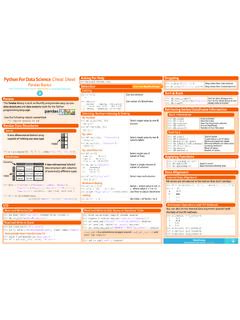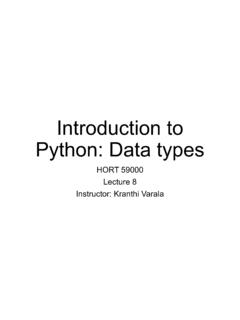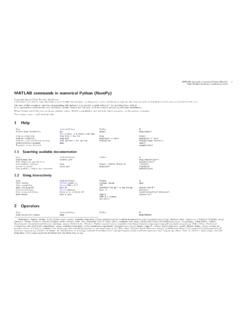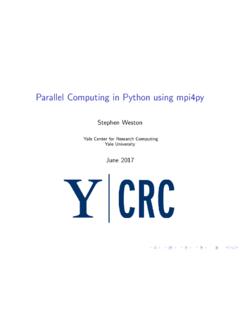Transcription of Reading Raster Data with GDAL - Utah State University
1 Reading Raster data with GDALOS python week 4: Reading Raster data [1]GDALOpen Source RS/GIS PythonWeek 4 GDAL Supports about 100 Raster formats ArcInfo grids, ArcSDE Raster , Imagine, Idrisi, ENVI, GRASS, GeoTIFF HDF4, HDF5OS python week 4: Reading Raster data [2] HDF4, HDF5 USGS DOQ, USGS DEM ECW, MrSID TIFF, JPEG, JPEG2000, PNG, GIF, BMP See available formats To see what formats are compiled into your version of GDAL, use this command in the FWTools shell (or terminal window on a Mac)OS python week 4: Reading Raster data [3]on a Mac)gdalinfo --formatsImporting GDAL Need to import both gdal and gdalconst FWTools:import gdal, gdalconstOS python week 4: Reading Raster data [4]import gdal, gdalconst Not FWTools:from osgeo import gdal, gdalconst All gdalconst constants start with a prefix which minimizes the possibility of conflicts with other modules Can import a module so you don t have to prefix things with the module name:OS python week 4: Reading Raster data [5]prefix things with the module name:import gdalfrom gdalconst import *orfrom osgeo import gdalfrom import *GDAL data drivers Similar to OGR data drivers Need to register a driver before using it Need to have a driver object before creating a new Raster data setOS python week 4: Reading Raster data [6]creating a new Raster data set Driver names (code) are available at Register all drivers at once Works for Reading data but not for creating data ()OS python week 4.
2 Reading Raster data [7] Get the Imagine driver and register it Works for Reading and creating new Imagine filesdriver = ('HFA') ()Opening a Raster data set Once the driver has been registered, the Open(<filename>, <GDALA ccess>)method can be used to return a Dataset objectOS python week 4: Reading Raster data [8]objectfn = ' 'ds = (fn, GA_ReadOnly)if ds is None:print 'Could not open ' + (1)Getting image dimensions Dataset objects have properties corresponding to numbers of rows, columns and bands in the data setcols = python week 4: Reading Raster data [9]cols = = = Notice no parentheses because they re properties not methodsGetting georeference info GeoTransforms are lists of information used to georeference an image From the GDAL documentation:adfGeoTransform[0] /* top left x */adfGeoTransform[1] /* w-e pixel resolution */OS python week 4: Reading Raster data [10]adfGeoTransform[1] /* w-e pixel resolution */adfGeoTransform[2] /* rotation, 0 if image is "north up" */adfGeoTransform[3] /* top left y */adfGeoTransform[4] /* rotation, 0 if image is "north up" */adfGeoTransform[5] /* n-s pixel resolution */ Coordinates are for top left cornersof pixels (unlike Imagine, which uses centers) Use the GetGeoTransform()method on a Dataset object to get a GeoTransformgeotransform = ()originX = geotransform[0]originY = geotransform[3]OS python week 4.
3 Reading Raster data [11]originY = geotransform[3]pixelWidth = geotransform[1]pixelHeight = geotransform[5]adfGeoTransform[0] /* top left x */adfGeoTransform[1] /* w-e pixel resolution */adfGeoTransform[2] /* rotation, 0 if image is "north up" */adfGeoTransform[3] /* top left y */adfGeoTransform[4] /* rotation, 0 if image is "north up" */adfGeoTransform[5] /* n-s pixel resolution */ Need to get pixel offsets from the upper left corner for specific coordinates x,yxOffset = int((x originX) / pixelWidth)yOffset = int((y originY) / pixelHeight)Computing pixel offsetsOS python week 4: Reading Raster data [12]yOffset = int((y originY) / pixelHeight)pixelHeightpixelWidth(origin X, originY)xy(x originX) / pixelWidth ~= (y originY) / pixelHeight ~= the integer values and we get (3,2)Getting individual pixel values Get the Band object by passing the band index (1-based) to the Dataset s GetRasterBand(<index>)methodband = (1)OS python week 4: Reading Raster data [13]band = (1) Read the data into a 2D Numeric array with ReadAsArray(<xoff>, <yoff>, <xsize>, <ysize>) data = (xOffset, yOffset, 1, 1) Even though we only read one pixel value, it is in a two-dimensional array Since we read one pixel in each direction, the array is of size 1x1 Need to specify both offsets, which are 0 OS python week 4.
4 Reading Raster data [14] Need to specify both offsets, which are 0 in this casevalue = data [0,0] Reading an entire image at once Use 0 offsets and pass the numbers of rows and columns to the ReadAsArray()methoddata = (0, 0, cols, rows)OS python week 4: Reading Raster data [15] Read individual pixels using [yoff, xoff] (math matrix notation is [row,col], not [x,y]) To read the pixel in the 95thcolumn and 43rdrow:value = data [42, 94]Memory management Set variables to None Especially important if you created large arrays with ReadAsArray()OS python week 4: Reading Raster data [16]band = Nonedataset = NoneScript example 1# script to get pixel values at a set of coordinates# by Reading in one pixel at a time# Took seconds on my machineimport os, sys, time, gdalfrom gdalconst import *# start timingstartTime = ()# coordinates to get pixel values forOS python week 4: Reading Raster data [17]# coordinates to get pixel values forxValues = [ , , ]yValues = [ , , ]# set (r'Z:\ data \Classes\ python \ data ')# register all of the ()# open the imageds = (' ', GA_ReadOnly)if ds is None:print 'Could not open image' (1)# get image sizerows = = = # get georeference infotransform = ()xOrigin = transform[0]yOrigin = transform[3]pixelWidth = transform[1]pixelHeight = transform[5]# loop through the coordinatesOS python week 4.
5 Reading Raster data [18]# loop through the coordinatesfor i in range(3):# get x,yx = xValues[i]y = yValues[i]# compute pixel offsetxOffset = int((x - xOrigin) / pixelWidth)yOffset = int((y - yOrigin) / pixelHeight)# create a string to print outs = str(x) + ' ' + str(y) + ' ' + str(xOffset) + ' ' + str(yOffset) + ' '# loop through the bandsfor j in range(bands):band = (j+1) # 1-based index# read data and add the value to the stringdata = (xOffset, yOffset, 1, 1)value = data [0,0]s = s + str(value) + ' # print out the data stringprint s# figure out how long the script took to runendTime = ()print 'The script took ' + str(endTime - startTime) + ' seconds'OS python week 4: Reading Raster data [19]Script example 2# script to get pixel values at a set of coordinates# by Reading in entire bands# Took seconds on my machineimport os, sys, time, gdalfrom gdalconst import *# start timingstartTime = ()# coordinates to get pixel values forOS python week 4: Reading Raster data [20]# coordinates to get pixel values forxValues = [ , , ]yValues = [ , , ]# set (r'Z:\ data \Classes\ python \ data ')# register all of the ()# open the imageds = (' ', GA_ReadOnly)if ds is None:print 'Could not open image' (1)# get image sizerows = = = # get georeference infotransform = ()xOrigin = transform[0]yOrigin = transform[3]pixelWidth = transform[1]pixelHeight = transform[5]# create a list to store band data inOS python week 4.
6 Reading Raster data [21]# create a list to store band data inbandList = []# read in bands and store all the data in bandListfor i in range(bands):band = (i+1) data = (0, 0, cols, rows) ( data )# loop through the coordinatesfor i in range(3):# get x,yx = xValues[i]y = yValues[i]# compute pixel offsetxOffset = int((x - xOrigin) / pixelWidth)yOffset = int((y - yOrigin) / pixelHeight)# create a string to print outs = str(x) + ' ' + str(y) + ' ' + str(xOffset) + ' ' + str(yOffset) + ' # loop through the bands and get the pixel valuefor j in range(bands): data = bandList[j]value = data [yOffset, xOffset] # math matrix notation orders = s + str(value) + ' # print out the data stringOS python week 4: Reading Raster data [22]# print out the data stringprint s# figure out how long the script took to runendTime = ()print 'The script took ' + str(endTime - startTime) + ' seconds'Assignment 4a Read pixel values from an image Print out the pixel values for all three bands of at the points contained in Use any method of Reading the Raster data OS python week 4: Reading Raster data [23] Use any method of Reading the Raster data that you want, but I would suggest one pixel at a time (fastest in this case since we don't need much data ) Turn in your code and the output (right-click in the Crimson Editor output window to copy all output) Reading Raster data efficiently Reading one pixel at a time is about as inefficient as you can get (DON T DO IT unless you just need a few pixel values here and there)OS python week 4.
7 Reading Raster data [24]here and there) Reading the entire image at once is pretty efficient, but not the best Plus, you might not have enough RAM to hold it all or process it Anyone seen the Block Size information in Erdas Imagine? Has to do with how the values are stored on disk Most efficient way to access Raster data is OS python week 4: Reading Raster data [25] Most efficient way to access Raster data is by blocks Unfortunately, don t always know block sizeGetting block size This week s data has a module called utils Can use it to get block size like this:import utilsblockSize = (band)OS python week 4: Reading Raster data [26]blockSize = (band)xBlockSize = blockSize[0]yBlockSize = blockSize[1]Tiled images By default Erdas Imagine abcA Some file types, like most GeoTIFFs, are not tiled A block is a rowOS python week 4.
8 Reading Raster data [27] By default Erdas Imagine files are tiled into blocks that are 64x64 pixels This example has 5x5 tilesABCR eading one row at a time Loop through the rows and read all pixels in that row during each iterationfor i in range(rows): data = (0, i, cols, 1)# do something with the data here, beforeOS python week 4: Reading Raster data [28]# do something with the data here, before# Reading the next row The built-in range(n)function creates a list of numbers from 0 to n-1>>> print range(10)[0, 1, 2, 3, 4, 5, 6, 7, 8, 9] Reading a row of blocks It s almost as easy to read in a row of blocks Need to check that we can get a whole block in abcAOS python week 4: Reading Raster data [29]can get a whole block in the y direction get an error if request more data than exists in the fileBC Use range(start, stop, step)to loop through each group of blocks>>> print range(0, 13, 5)[0, 5, 10]bSize = 5abcAOS python week 4: Reading Raster data [30]bSize = 5for i in range(0, rows, bSize):if i + bSize < rows:size = bSizeelse:size = rows - idata = (0, i, cols, size)# do something with the data here, before# Reading the next set of blocksBCrows = 13bSize = 5for i in range(0, rows, bSize):if i + bSize < rows:size = bSizeelse:size = rows - idata = (0, i, cols, size)OS python week 4: Reading Raster data [31]i = [0, 5, 10]0 + 5 < 13, so size = 5 ReadAsArray(0, 0, 11, 5)abcABCabcABCrows = 13bSize = 5for i in range(0, rows, bSize):if i + bSize < rows:size = bSizeelse.
9 Size = rows - idata = (0, i, cols, size)OS python week 4: Reading Raster data [32]i = [0, 5, 10]5 + 5 < 13, so size = 5 ReadAsArray(0, 5, 11, 5)abcABCrows = 13bSize = 5for i in range(0, rows, bSize):if i + bSize < rows:size = bSizeelse:size = rows - idata = (0, i, cols, size)OS python week 4: Reading Raster data [33]i = [0, 5, 10]10 + 5 > 13, so size = 13 10 = 3 ReadAsArray(0, 10, 11, 3)abcABCR eading block by block The most efficient way to read data Use one loop for the rows and one for the abcAOS python week 4: Reading Raster data [34]rows and one for the columns Need to check that there is an entire block in both directionsBCrows = 13, cols = 11range(0,13,5) & range(0,11,5) both return [0, 5, 10]xBSize = 5yBSize = 5for i in range(0, rows, yBSize):if i + yBSize < rows:numRows = yBSizeabcAOS python week 4: Reading Raster data [35]numRows = yBSizeelse:numRows = rows ifor j in range(0, cols, xBSize):if j + xBSize < cols:numCols = xBSizeelse:numCols = cols jdata = (j, i, numCols, numRows)# do something with the data here, before# Reading the next blockBCrows = 13, cols = 11, xBSize = 5, yBSize = 5for i in range(0, rows, yBSize):if i + yBSize < rows:numRows = yBSizeelse:numRows = rows ifor j in range(0, cols, xBSize):if j + xBSize < cols:numCols = xBSizeelse:numCols = cols jOS python week 4: Reading Raster data [36]numCols = cols jdata = (j, i, numCols, numRows)i = [0, 5, 10]0 + 5 < 13, so numRows = 5j = [0, 5, 10]0 + 5 < 11, so numCols = 5 ReadAsArray(0, 0, 5, 5)abcABCrows = 13, cols = 11, xBSize = 5, yBSize = 5for i in range(0, rows, yBSize):if i + yBSize < rows:numRows = yBSizeelse.
10 NumRows = rows ifor j in range(0, cols, xBSize):if j + xBSize < cols:numCols = xBSizeelse:numCols = cols jOS python week 4: Reading Raster data [37]nu





